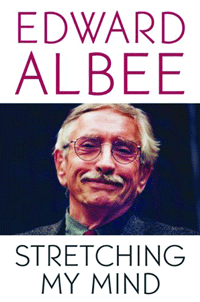Volume 4, Number 48 | December 1 – 7, 2005
BOOKS
Still Standing, Before Us
Edward Albee stretches himself, and all who find their way to his art
“I’ll keep on writing as long as I think I have something interesting to write about,” he said. “I might eventually prove to be wrong and I hope I’ll know when to stop.”
On a cold rainy day in late November, Albee took the subway up and back from his Tribeca home to the Manhattan Neighborhood Network studio in Hell’s Kitchen to tape an interview with Ann Northrop and this reporter for the “Gay USA” cable TV show. Our greatest living playwright, with “Seascape” on Broadway and the recent New York production of “Who’s Afraid of Virginia Woolf?” headed to the West End, could certainly afford to travel more comfortably, but his style is resolutely unpretentious.
Earlier in the month, Albee, 77, accepted the lifetime achievement award from SAGE (now known as Services and Advocacy for Gay, Lesbian, Bisexual, and Transgender Elders). He noted that he had thought of himself as middle-aged until he got the group’s invitation. How is old age treating him?
“I’m thinking of going back to being middle aged,” was Albee’s response.
At the SAGE event, he was lauded by actors Elaine Stritch, Marian Seldes, and Brian Murray as well as producer Liz McCann.
“It doesn’t get much better than that,” he said with a combination of pride and appreciation for people who have brought his works to life.
Albee told the SAGE crowd that he had been out since he was 12. What was that like around 1940, I asked.
“I was doing what everyone else was doing” at his boy’s school, he said. “I don’t know that I was accepting who I am, but boy was I having fun. I don’t ever recall being made to transition from doing what was natural to doing what was going to be unaccepted.”
Albee did say that he didn’t like the “values” of his adoptive parents.
“They were bigots, they were racists, they were Republicans—even then a terrible thing. I didn’t like them,” he said. “I guess I thought it would be nice to be as different from them as possible. But I don’t think that persuaded me to stay being gay. I was perfectly happy with it.”
Talking about Republicans prompted him to offer his theory of how they convinced the nation to put them in a position which, he said, “allowed them to destroy everything the New Deal accomplished—which is what they’re after—and destroy democracy, too.”
“I think somewhere along the line one of those Republicans got the bright idea: ‘You know, all those working class people are voting against us—they’re voting Democratic. Let’s tell them they’re not working class. Tell them they’re middle class,’” Albee said with a gleam in his eye. “The middle class is more reactionary.
“The Democrats should just remind the middle class that they’re really working class” if they want to win majorities again, he concluded.
The following evening when I sat watching Mike Leigh’s “Abigail’s Party” starring Jennifer Jason Leigh, a painfully funny indictment of reactionary middle class people clawing to keep up with the Joneses, I couldn’t get Albee’s deceptively simple idea about class identity out of my head.
Albee, as usual, is on to something as he has been for more than four decades now from “The Zoo Story” in 1959 to “The Goat or, ‘Who is Sylvia?’” in 2004—a much longer and complex arc than it sounds. The late Mel Gussow called his excellent biography, “Edward Albee: A Singular Journey.”
What was the journey from suburban Westchester to a breakthrough play at 30?
“I started writing poetry at eight,” he said. “Wrote two terrible novels in my teens. The short story and I had different ideas about its nature and I was a creative writer, so I didn’t have to worry about being able to think in a straight line, so I didn’t do essays very well. But I was a writer.”
Albee said he educated himself in “life and the arts” in the Village after leaving home at 18 and took up playwriting again. Asked about the challenging nature of all his work, he said, “It seems to me if you don’t write something or paint something or compose something that makes people think a little differently about themselves and their lives, you are wasting your own time and theirs. The arts are there to make us see things better—more clearly, differently. And if you are supposed to do that, then you want to shake people up a little bit.”
A bit?
“Zoo Story” was a revelation, but “Who’s Afraid of Virginia Woolf?” was an explosion when it opened on Broadway in 1962, changing expectations forever about what could happen on a stage. Albee was voted the Pulitzer Prize for the first of four times, but in the case of “Woolf,” the mandarins of Columbia University, home of the Pulitzers, overruled their own committee and kept the prize from being awarded to him.
Undaunted by the Columbia snub, he poured a good portion of the profits from “Woolf” into the Edward F. Albee Foundation he established for creative artists in Montauk, where candidates are selected “for talent and need.”
The playwright’s “Seascape,” which won the Pulitzer in 1975, couldn’t be timelier back on Broadway what with the national uproar over intelligent design rhetoric being used by the right wing to challenge the science of evolution.
“I wrote because after looking around at people, I was beginning to wonder if evolution had really taken place and whether or not the so-called ‘lower forms of life’ might not be a little smarter than we are,” he said.
Albee would be happy to have a larger audience for his work than those who make it to legitimate theaters, but he will not give up control of any of his works so that a filmmaker can change them. He has been happy “far more than chance would have it” with the stage productions of his work worldwide, but noted, “There are three actors—I’m not going to tell you who they are—who I tell everybody never to work with, but considering the hundreds I’ve worked with, I’ve been very fortunate.”
He will get a larger audience in a different medium with his new book of essays, “Stretching My Mind” that he calls “42 pieces of my mind” spanning 45 years, mostly on theater and other arts, but also on the political scene. Included is an essay on the work of his life partner, sculptor Jonathan Thomas, who died of cancer in May, and excerpts of a conversation with Thomas and art historian Harry Rand.
Edward Albee doesn’t much like talking about his works in progress, he explained, “because I might be wrong” about how they will turn out.
“There’s about two weeks after I finish a play when I know how to talk about it and after that, I’m just guessing as much as anyone else,” he said.
Albee was willing to divulge, however, that he is at work on two plays, “one about identical twins, one of whom has a doppelganger,” called “Me, Myself and I.”
For 15 years, Albee taught at the University of Houston, stopping when Thomas became ill two years ago. He was “teaching young playwrights how to be themselves. I learned a lot about teaching and playwriting.”
Is it hard for Albee to be himself?
“There you are standing naked before the world—and some people don’t like being naked,” he said, and then added, “I’m fond of it.”
For more information on Albee’s foundation in Montauk, visit albeefoundation.org. Albee will appear in conversation with Jesse Green of The New York Times on Monday, December 5 from 6:30-8 p.m. at the LGBT Community Center, 208 W. 13th Street. Seating is on a first-come, first-served basis, with a suggested donation of $10.
gaycitynews.com

































